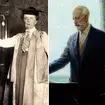Tchaikovsky - Romeo and Juliet
No one who listens to Tchaikovsky’s Romeo and Juliet can be in any doubt that this Russian composer certainly gives Rachmaninov a run for his money in the heart-on-your-sleeve stakes.
Composed in 1869, and sandwiched between his Symphonies No. 1 and No. 2, this was arguably Tchaikovsky’s first true masterpiece. The composer’s inspiration was, as the title suggests, the famous Shakespeare play. It was the Russian composer Mily Balakirev who gave Tchaikovsky the idea of taking the English playwright’s work and setting it to music. indeed, he chose to dedicate Romeo and Juliet to Balakirev – a man he looked up to and sought advice from in the early part of his career.
Existing as a single-movement work and lasting around twenty minutes, Romeo and Juliet makes full use of the orchestra’s sweeping string section. Layer on layer of sumptuous melodies are woven together, with various tunes depicting particular sections of the plot.
As with all too many of Tchaikovsky’s works, this one was dismissed at its premiere. But looking back now, with the whole of the composer’s career in our line of sight, it’s clear that Romeo and Juliet was the first true example of Tchaikovsky’s emergence as a musical genius.
Recommended recording
Orchestra of the Academy of St Cecilia; Antonio Pappano (conductor).
EMI classics: 0946 3700652.
Illustration: Mark Millington


























